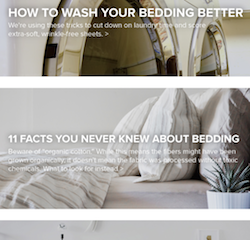Content marketing
- laura
- January 15, 2015
- Best practices
 There are a lot of mailing lists I’m on simply because I can’t be bothered to unsubscribe. Every week or every few days mail shows up in my inbox. I may look at the subject line, I may even open the message. But most of it is not interesting. It’s yet another sale at Sur La Table. It’s another promo from Macheist. Virgin America wants me to book a flight. All of these messages are useful and all, particularly if I’m trying to book a flight or looking to replace the dish I broke last week. But many of these companies send content that’s so close to the same, it’s not worth a whole lot of my attention.
There are a lot of mailing lists I’m on simply because I can’t be bothered to unsubscribe. Every week or every few days mail shows up in my inbox. I may look at the subject line, I may even open the message. But most of it is not interesting. It’s yet another sale at Sur La Table. It’s another promo from Macheist. Virgin America wants me to book a flight. All of these messages are useful and all, particularly if I’m trying to book a flight or looking to replace the dish I broke last week. But many of these companies send content that’s so close to the same, it’s not worth a whole lot of my attention.
I don’t think I’m that unusual in this respect. People are used to getting offers and so they know they can sit back and wait until they’re ready to shop and they’re ready to buy.
This is why content marketing can be such a win. It’s different, it’s new. It’s worth my time to dig into the email and read it. We recently bought some sheets from a company and they added me to their mailing list. Every week now, I get an email with lovely pictures of relaxing bedrooms and articles on how best to sleep and wash my sheets and replace my pillow cases.
From a consumer perspective, it makes me want to have a showroom bedroom with lots of comfy linens. From a marketing perspective I appreciate the hard work and dedication that goes into generating both the lovely pictures and the useful content. But I wonder if the effort put into the content generation provides a decent return on investment.